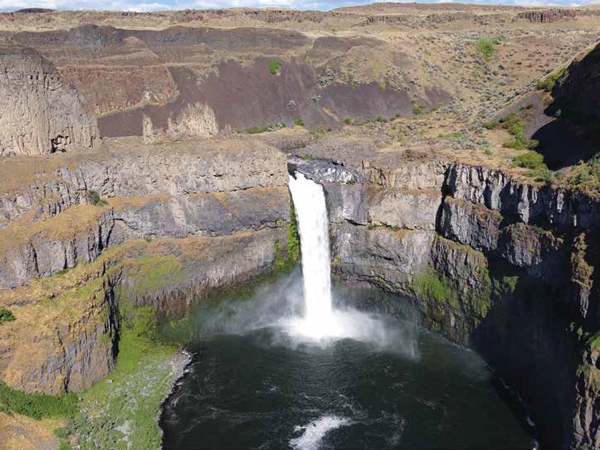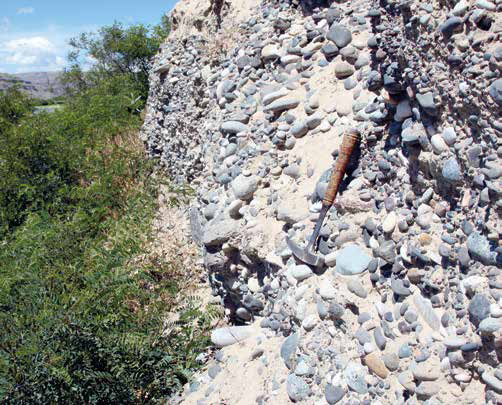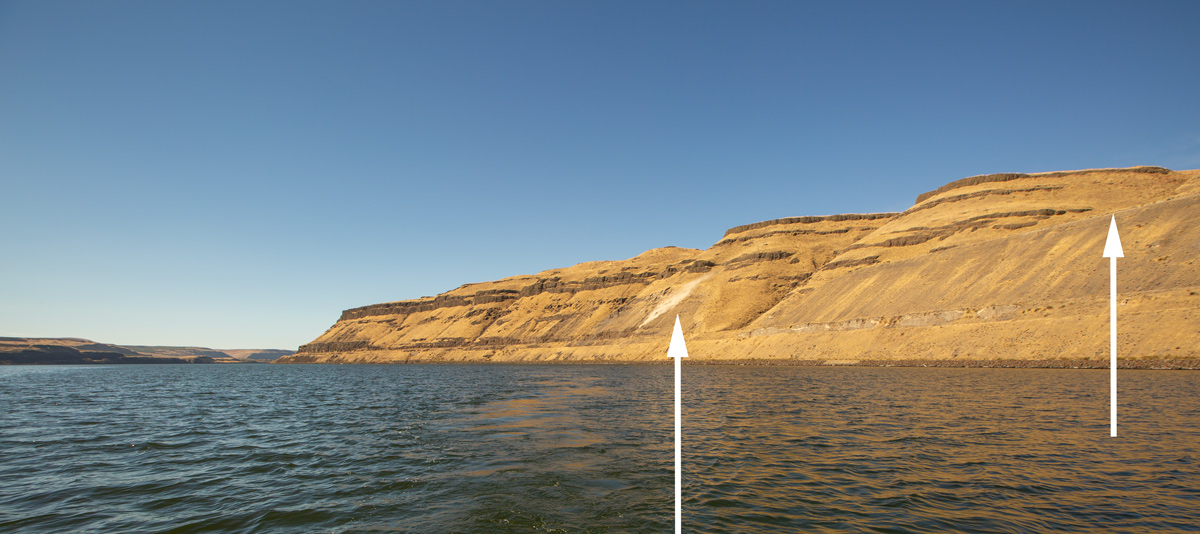Lake Missoula Floods
Palouse Falls is a spectacular example of Miocene-age igneous flood basalts that were subsequently abraded and carved by the colossal Pleistocene-age floods. Its broad, eroded valley and outsized plunge pool were not formed by the present-day flow of the Palouse River, but by tumultuous, ice-laded floodwaters from Glacial Lake Missoula that swept over the Channeled Scablands.
From the moment they dipped their paddles into the Snake River, the Lewis and Clark expedition would not only be following the path of multiple flood basalt flows, but also the route of the colossal Glacial Lake Missoula floods that so markedly scoured the basaltic landscape.[2]See on this site Columbia River Basalts. Three of the most popular narratives of the Missoula floods, often dubbed the Ice Age Floods, are John Eliot Allen, Marjorie Burns, and Scott Burns, … Continue reading During the last glacial period in the Pleistocene,[3]During the Pleistocene Epoch, which began about 2.588 million years ago, much of southwestern Canada was repeatedly glaciated by a series of Cordilleran ice sheets that extended into northern … Continue reading a glacial lobe from the massive Cordilleran ice sheet advanced southeastward of present-day Lake Pend Oreille near the Idaho-Montana border. It dammed the natural outlet of Clark Fork River, thus creating a nearly two hundred-mile long impoundment in western Montana now referred to as Glacial Lake Missoula. Following the catastrophic failure of the approximately 2,000-foot high ice dam, along with multiple other large-scale releases of lake waters between about 15,000 and 18,500 calendar years ago,[4]The cyclic ice damming/filling and subsequent release of Glacial Lake Missoula floodwaters occurred numerous times in the late Wisconsin, most probably between 12,700 and 15,300 radiocarbon years … Continue reading floodwaters repeatedly burst out of Lake Missoula and rushed westward seeking a route to the sea.[5]It is believed these flooding events were separated by a few years to six decades, per Richard B. Waitt, Jr., “Periodic Jökulhlaups from Pleistocene Glacial Lake Missoula—New Evidence from … Continue reading The largest and earliest floods may have flowed freely through the northern Columbia River Valley,[6]Gerardo Benito and James (Jim) E. O’Connor, “Number and Size of Last-Glacial Missoula Floods in the Columbia River Valley between the Pasco Basin, Washington, and Portland, Oregon,” … Continue reading but subsequent releases from Lake Missoula encountered Glacial Lake Columbia, itself created by another Cordilleran glacial lobe damming the Columbia River. With no outlet in that direction, Missoula floodwaters spilled over the low drainage divide to the south in a myriad of stupendous cascades and torrents moving upwards of thirty to sixty miles per hour or more.[7]One can find different Missoula flood speed estimates in virtually every reference work of this phenomenon, depending on whether a researcher is referring to flow in a hydraulically impounded reach … Continue reading The sheer force, volume, and speed of this ice and rock-laded water instantaneously denuded the landscape, stripping away soil and vegetation and carving deep canyons along its flood path throughout an area now known as the Channeled Scablands, while also depositing oversized sand and gravel bars.[8]Two exceptional geologists, J [no period after the J] Harlen Bretz and Joseph T. Pardee, are credited with deducing the erosional mechanism and water source that created the Channeled Scablands. … Continue reading
Notable Evidence
Representative exposure at Central Ferry, Washington, of the “stoney” deposits of “a round smooth kind” encountered by the expedition along the Snake River. These pebble, cobble, and boulder-sized stones, and the gravelly deposits observed farther downstream, were deposited by enormous flooding events in the Snake River valley.
The entire expedition route on the Snake and Columbia Rivers is marked by evidence of these gargantuan floods, including the 184-foot high Palouse Falls, the only active waterfall left along glacial flood path in the Channeled Scablands. Located about five miles up what the captains named “Drewyers River,” the expedition members did not see the falls because they did not reconnoiter that far upstream. Had they seen it, certainly the beauty of the falls and its basalt flow architecture[9]The lip of Palouse Falls is notched into oldest flow of the Frenchman Springs Member of the Wanapum Basalt, and the underlying cliffs are comprised of the Grande Ronde Basalt. would have been worthy of mention, but how curiously undersized the river and narrow falls were compared to its broad, eroded valley and outsized plunge pool might not have been noted by the explorers. Such an insight would require imaging the entire landscape being abraded and torn asunder under hundreds of feet of tumultuous, ice- and rock-laded Missoula floodwaters.
Descriptions from the Journals
Lake Sacajawea Bar
© 10 October 2015 by Kristopher K. Townsend. Permission to use granted under the Creative Commons Attribution-Share Alike 4.0 International license.
Left arrow: a small landslide creates a dust cloud.
Right arrow: The downstream end of the Lake Sacajawea Bar, a massive longitudinal eddy bar left by the Lake Missoula Floods. To the right, the bar quickly rises to 400 feet above the river. The abandoned Spokane, Portland, and Seattle railway bed cuts through the soft material just above the tips of both arrows. The rail bed is now the Columbia Plateau State Park and provides hiking access along the lower Snake River.
—Kristopher K. Townsend, ed.
Close examination of the expedition journals reveals that Lewis, Clark, and the other journal keepers took note of key physical evidence of epic flooding events. For example, Clark noted on 11 and 12 October 1805, primarily in his courses and distances, the “stoney” composition of the islands in the Snake River, while Gass remarked on 11 October 1805 that the “bed and shores of the river are very stony” and the stones were of “a round smooth kind.” These were pre-Missoula flood deposits, which are the predominantly stony sediments found from the confluence of Snake and Clearwater Rivers to about 7.5 miles eastward of the mouth of the Palouse River. An excellent exposure of these “stoney” deposits can be found on the north bank of the Snake River at Central Ferry, fortunately still visible above the impounded water of Lake Bryan behind Little Goose Dam. These pebble, cobble, and boulder-sized stones are comprised of many different lithologies[10]According to the geological map of this region, and verified through my own field observations, these light to dark gray, greenish gray, olive gray, grayish red, grayish red purple, grayish orange … Continue reading but their markedly well-rounded shapes disclose a final turbulent, shared journey from perhaps as far distant as the ancestral Salmon River.
Clark was a bit more descriptive of flood depositional features on 15 October 1805:
The Islands of different Sizes and all of round Stone and Sand.
Because the easternmost discharge of the Missoula floods was the Palouse River (which the floods re-routed from its original course down Washtucna Coulee), the “round Stone” Clark described on 15 October (downstream of the Snake-Palouse River confluence) was a Missoula flood outburst gravelly deposit. Geologists can differentiate between pre-Missoula flood deposits such as the aforementioned Central Ferry exposure and Missoula flood gravels because the latter deposits are almost completely comprised of basalt gravels (>95%), direct evidence that the Missoula floods swept over, and plucked, wrenched and scoured rocks from a nearly uniform basaltic landscape. Ever diligent in his observations, on 16 October 1805, Clark would correctly describe another one of these Missoula flood outburst deposits as a “gravelley bare.”
Notes
| ↑1 | John W. Jengo, “After the Deluge: Flood Basalts, Glacial Torrents, and Lewis and Clark’s “Swelling, boiling & whorling” River Route to the Pacific,” We Proceeded On, August 2014, Volume 40, No. 3, the quarterly journal of the Lewis and Clark Trail Heritage Foundation. The original, full-length article is provided at https://lewisandclark.org/wpo/pdf/vol40no3.pdf#page=9. |
|---|---|
| ↑2 | See on this site Columbia River Basalts. Three of the most popular narratives of the Missoula floods, often dubbed the Ice Age Floods, are John Eliot Allen, Marjorie Burns, and Scott Burns, Cataclysms on the Columbia, The Great Missoula Floods (Portland, Oregon: Ooligan Press, 2009), David D. Alt, Glacial Lake Missoula and Its Humongous Floods (Missoula, Montana: Mountain Press Publishing Company, 2001), and for geologists who are seeking to visit specific flood evidence localities, Bruce Bjornstad, On the Trail of the Ice Age Floods: A Geological Field Guide to the Mid-Columbia Basin (Sandpoint, Idaho: Keokee Company Publishing, Inc., 2006). |
| ↑3 | During the Pleistocene Epoch, which began about 2.588 million years ago, much of southwestern Canada was repeatedly glaciated by a series of Cordilleran ice sheets that extended into northern Washington, Idaho, and Montana. In North America, the most recent glacial period is termed the Wisconsin, which began about 85,000 years ago and ended around 11,700 years ago. |
| ↑4 | The cyclic ice damming/filling and subsequent release of Glacial Lake Missoula floodwaters occurred numerous times in the late Wisconsin, most probably between 12,700 and 15,300 radiocarbon years Before Present. See Richard B. Waitt, Jr., “Case for Periodic, Colosal Jökulhlaups from Pleistocene Glacial Lake Missoula,” Geological Society of America Bulletin, 96:10 (October 1985):1271-1286. It is common to encounter other age ranges for the Missoula floods in the scientific literature (such as between 13,350 and 15,550 radiocarbon years Before Present) so I could have alternatively cited an age range of 15,500 to 18,700 calendar years ago. Subsequent research has broadened the potential time span of flood events from post-22,600 calendar years ago to perhaps hundreds of years past 15,000 calendar years ago, but I opted to cite the more narrowly defined and commonly accepted time span. |
| ↑5 | It is believed these flooding events were separated by a few years to six decades, per Richard B. Waitt, Jr., “Periodic Jökulhlaups from Pleistocene Glacial Lake Missoula—New Evidence from Varved Sediment in Northern Idaho and Washington,” Quaternary Research, 22:1 (July 1984):46-58. Jökulhlaup is an Icelandic term for a large, abrupt outburst flood that occurs from the release of water below a glacier. |
| ↑6 | Gerardo Benito and James (Jim) E. O’Connor, “Number and Size of Last-Glacial Missoula Floods in the Columbia River Valley between the Pasco Basin, Washington, and Portland, Oregon,” Geological Society of America Bulletin, 115:5 (May 2003):624-638. I have excluded from my discussion the very last, post Lake Missoula floods (referred to as “non-Missoula” floods) that were restricted to the Columbia River valley in the waning years of the continental deglaciation. Those events bypassed the Channeled Scablands. |
| ↑7 | One can find different Missoula flood speed estimates in virtually every reference work of this phenomenon, depending on whether a researcher is referring to flow in a hydraulically impounded reach (where speeds from 11 to 45 mph have been estimated) to nearly 80 mph where floodwaters were funneling through a constriction (accelerating according to the Venturi effect). See Benito and O’Connor, “Number and Size,” 115:5, 634-635. |
| ↑8 | Two exceptional geologists, J [no period after the J] Harlen Bretz and Joseph T. Pardee, are credited with deducing the erosional mechanism and water source that created the Channeled Scablands. Starting with his first published papers in 1923, Bretz recognized that only flowing water could have carved such features, but he did not have a source of the massive volume of water required to form them. In fact, he named the outbreak the “Spokane Flood” because he thought the source of the water was near Spokane, Washington. Commencing his work in 1910, Pardee deduced the existence of Glacial Lake Missoula; subsequent study of valley-scale ripple marks much larger than those found in ordinary rivers or streams convinced Pardee that such features could only be created by massively deep and vigorous currents associated with cataclysmic draining of the lake. It was the unification of these two theories that explained the creation of the Channeled Scablands and the numerous sedimentological features to be found along the flood path. |
| ↑9 | The lip of Palouse Falls is notched into oldest flow of the Frenchman Springs Member of the Wanapum Basalt, and the underlying cliffs are comprised of the Grande Ronde Basalt. |
| ↑10 | According to the geological map of this region, and verified through my own field observations, these light to dark gray, greenish gray, olive gray, grayish red, grayish red purple, grayish orange pink and blackish red pre-Missoula flood deposits are comprised of approximately 30% basalt and 70% percent metavolcaniclastic, porphyritic, granitic, and metamorphic rocks, with quartzite particularly notable. See J. Eric Schuster, Charles W. Gulick, Stephen P. Reidel, Karl R. Fecht, and Stephanie Zurenko, Geologic Map of Washington—Southeast Quadrant, Washington Division of Geology and Earth Resources Geologic Map GM-45, 1997, Sheet 1, scale 1:250,000. |
Experience the Lewis and Clark Trail
The Lewis and Clark Trail Experience—our sister site at lewisandclark.travel—connects the world to people and places on the Lewis and Clark Trail.
Discover More
- The Lewis and Clark Expedition: Day by Day by Gary E. Moulton (University of Nebraska Press, 2018). The story in prose, 14 May 1804–23 September 1806.
- The Lewis and Clark Journals: An American Epic of Discovery (abridged) by Gary E. Moulton (University of Nebraska Press, 2003). Selected journal excerpts, 14 May 1804–23 September 1806.
- The Lewis and Clark Journals. by Gary E. Moulton (University of Nebraska Press, 1983–2001). The complete story in 13 volumes.




